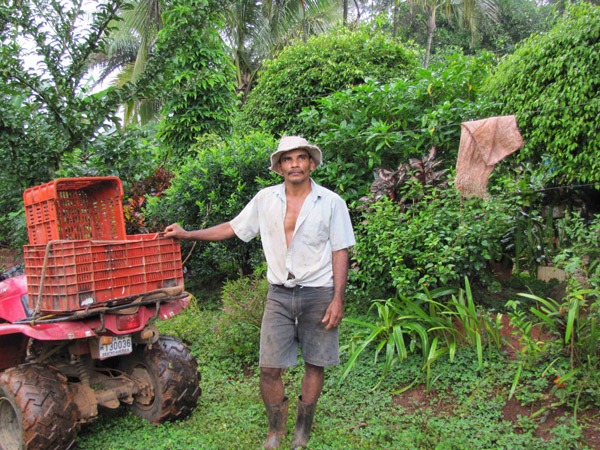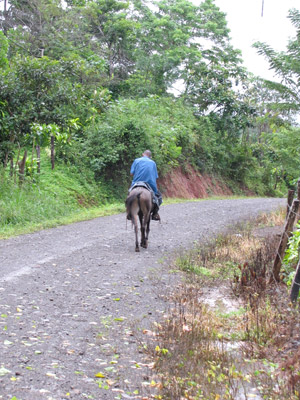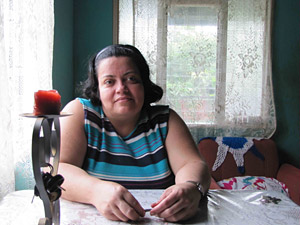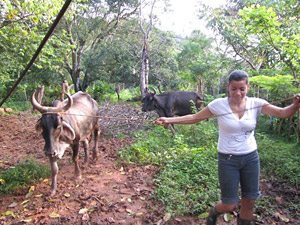|
The road that goes through this small yet beautiful town located amid Nicoya’s mountains is the only alternate route for Nosara communities when route 160 is closed down. Although many people learned about the road’s bad conditions on Thursday, November 4th, after a bridge collapsed cutting off Nosara, Zaragoza´s residents have known this for years, and they also have been waiting for years for the improvements to arrive that were promised long ago.
However, if the road does arrive, how will it affect the town’s residents? In an attempt to answer these questions, Spanish-born writer Joaquín Giménez Name, lived with one of the area’s families for four days and shared with us his perceptions.

Severo Campos posing next to his quad, before starting his work day

One of Zaragoza’s residents, on his way to work |
|
The sky is still dark, a dog is barking and, in reply to his call, other dogs bark back silencing the whistling of nocturnal insects. The first rays of dawn slowly begin to show through the East as the residents of Zaragoza start a new day.
It is 5 a.m. and the Campos Chavarría family awakes. The mother, Gretel Chavarría, starts preparing breakfast over the wood stove: coffee and pinto with cheese and corn tortillas, while her children are getting ready for school. While he waits for breakfast to served, Severo Campos, the father, is sitting by the front door with a cup of coffee in his hand, his work day in the fields will start at six.
Here in Zaragoza agriculture is the only source of income: beans, rice, corn, fruit trees, produce from the garden and of course, coffee. During the dry season families pick coffee, most of them selling it to the local Cooperativa, thereby guaranteeing some sort of income for their family for the rest of the year.
Lidieth Carrillo is the teacher for the 27 students in the school. Carrillo has been in town for over ten years and enjoys living here: there is great natural beauty with a peaceful and healthy lifestyle. On one of the school’s walls, a mural reads: “Vivan siempre el trabajo y la paz” (Long live work and peace). This seems to be the motto for Zaragoza’s residents. No one is unhappy about living here?, I ask, “Well, whoever doesn’t like it leaves”, Carrillo replied.
There used to be no school transportation to go beyond Zaragoza and thus, when children turned twelve and finished elementary school, they were unable to continue their studies. However, since the year 2000, a bus service is available to take students to the high school in Belén, 15 km away. The road to Belén is a dirt road in good condition. It comes out onto the road to Nicoya. In contrast, the road from Zaragoza to Nosara is impassable during the rainy season, leaving the town out of the regular tourism routes.
Five years ago electricity arrived in Zaragoza but the Jirón family has not yet hooked up. In their free time, Gerardo Jirón, the father, carves wooden figures while one of his daughters makes paintings.
Next to the Jirón’s home is their coffee plantation, perched atop a mountain. They do not sell their coffee to the Cooperativa, instead they roast and grind it themselves during the summer months. Gerardo rides down to Nosara on his horse to sell his coffee to the area hotels. This is not an easy thing to do, not even for a horse, during the rainy season, venturing down the uneven and muddy road that takes them to the coast.
The area’s residents have high hopes for this road: if its conditions are improved, more people will visit the town, activating its economy and those who work in Nosara will have an easier time getting there. However, the cost is high and the project depends on the approval of the government, and this implies a long wait.
Zaragoza is a town of about two hundred residents in approximately fifty homes. These homes are not surrounded by fences or gates, nor do they have alarm systems. Here everybody knows each other. Residents appreciate the peace and tranquility. Therefore, although many people wish that the road would bring economic growth to the town, they can’t help but think that development might also attract crime, which has been non-existent to this day.
Gretel Chavarría’s parents, Carlos and América, came to Zaragoza 35 years ago looking for better opportunities. “I guess that’s what we are all looking for, right?” asks Carlos Chavarría while he sits on a chair on his front porch. Next to him, América nods. “When we arrived,” he explains, “we bought a property.” “Were there any property deeds at the time?” I ask. “No,” he replies, “in those days, one’s word was enough.”
About fifteen years ago, people started registering their property; the process is slow and complicated, so not everyone has done it. But every person knows what belongs to their neighbor and everyone respects it. This may seem almost impossible in a city, or even in other rural areas, but in Zaragoza people still trust their neighbors.
Howard Kramer is known by everyone as Howie. Originally from New York, Kramer came to Costa Rica in 1988 to adopt his daughter. He liked the country and decided to retire in Nosara; in 2005, he took on the adventure of moving to Zaragoza. Howie financed the construction of a water tank for the town, since they usually had to endure many water restrictions during the dry season. This, along with his friendly attitude, has earned him a special place in the community. Kramer believes that fixing the road to Nosara is important and is convinced of the town’s possibilities for development.
|
| |
|

Gretel Chavarría in the family’s living room |
|
| |
|

Carlos Chavarría in his garden |
|
| |
|
 |
|
| |
|

It is a clear day and Howie and Kuzu enjoy themselves will playing some basketball after cleaning the court |
|
| |
|

Elieth Campos Chavarría returns a cow to its shed after milking it |
|
I am now back in the Campos Chavarría family home. They have welcomed me while I’m writing this article. After dinner, Eliezer, the only son and the youngest member of the family, is rolling around on the floor playing with the cat and with some small metal cars. Gretel and Severo are watching TV while I am chatting with their daughters. They have three: Ruth, Elieth and Lineth. The girls go to school outside Zaragoza and, whenever they can, they also help out with some of the work to be done on the farms, such as milking cows or picking coffee during the summertime.
Would you like to go on living here? I ask them. They look at each other and Elieth answers that, if the town grows a bit more (and this, of course, depends on the improvement of the conditions of the road that leads to Nosara), then yes.
And what about the rest of the people your age? Once again, they look at each other. “Some wish to go to a larger place, one that offers more opportunities and that is more modern,” they answer. “And, whoever doesn’t like it leaves,” I tell them, repeating the teacher’s words. They laugh and point out that she has stayed.
Nighttime has fallen and the family has gone to bed. I am in the bedroom that they have given me and I am slowly falling asleep, listening to the pattering of the rain on the metal roof. Suddenly, the family dog barks in the yard next to my window and, almost instantly, several dogs answer back.
Zaragoza leaves a good impression, something similar to childhood, when one still awaits with great expectations the opening of new roads, with all the advantages and risks that they may bring.
----------------------------------------------
CLICK BELOW FOR A PDF DOWNLOAD
"Matasapo" by Howard Kramer, chapter "The Road Brings The Future"

 |
| |
More Regional News
Total Lunar eclipse viewed from Nosara
On December 21st, from 1:30 to 3:30 am, photographer Rolf Sommer stayed up to see and photograph this unique event. More >
The end of the year might bring a new bridge to Rosario and Montaña rivers
• Decision was made during tropical storm Thomas
The State acquired two Bailey bridges (which can be disassembled) to place over Rosario and Montaña rivers. Now one is being placed over the first river. The job is being handled by Maicom S. A. construction, and it is hoped that it will be finished before the year ends. The work of placing the other bridge begins the second week of January, Vice Minister of Public Works María Lorena López let VON know by telephone. More >
Crime Appears to be Down but Need for Local Support Continues
The Tourist Police stationed at Playa Guiones appear to be deterring crime, but the delegation of twelve officers continues to face challenges related to local financial support, as well as some bureaucratic issues. More >
Border Crossing
Calm at the Border inspite of conflict between Nicaragua and Costa Rica
As I prepared for a trip to Nicaragua, several of my Costa Rican friends expressed concern because of the current friction between the governments of the two countries. A couple people even suggested I go to Panama to renew my visa instead. The two countries have been in conflict since October 2010 regarding sovereignty of the river San Juan. More >
Tropical Storm Thomas
Damages Due to Rains Add Up and Increase Each Year
Adriana Sequeira and Jonathan Baltodano are among the 246 families that were affected by the last swell of the Río Nosara. On the evening of Friday, November 5th, the river forced them to take all their furniture out of their home. They had to spend the night out in the open, in their neighbor’s small ranchito. More >
Palí opened a new store in Samara
• Low prices and competition will impact local supermarkets
On November 12, the highly anticipated Palí opened its doors in Samara with a festive atmosphere. Many people went to check out the new store, and especially to check out the low prices. But not everyone is happy to have a big chain store like Palí in Samara. Some worry about the effect it might have on local supermarkets and pulperias (small local stores that sell the basics). More >
Earthquake Will Destroy Poor Quality Constructions in Nicoya Peninsula
• The Comisión Nacional de Emergencias accepts that most homes don’t meet Seismic Building Code standards
For a while now, scientists have been studying seismic activity and its potential in the Nicoya Peninsula, and the Observatorio Vulcanológico y Sismológico de Costa Rica (OVSICORI) has estimated that the next earthquake along the fault here could be between a magnitude of 7.7 and 7.9. But what would such a strong earthquake mean for people with homes in the Nicoya, Samara and Nosara areas? More >
2010 Municipal Elections – intelligent vote
Know the Candidates for Syndics
and What They Do More >
Syndic hopefuls aspire
to decentralize the Municipality
Next Sunday, December 5, five political parties have prepared their fifteen syndic candidates for the districts of Nicoya, Samara and Nosara to be elected to the municipality to fill the next term which, in this instance, will be six years. More >
Government Gives More Than $12,000 to Three Local Schools
• Funds for the Serapio López Elementary School were almost lost
Through Nicoya’s Municipalidad, the government granted over $12,000 to three local elementary schools to be used for purchasing construction materials. The schools that were favored are Santa Marta, Santa Teresita and Nosara’s Serapio López. More >
Brief Police News
Confrontation Between Juvenile Gangs on the Rise in Nosara More >
Seven Security Cameras Installed in Guiones More >
|
 |
|
|

